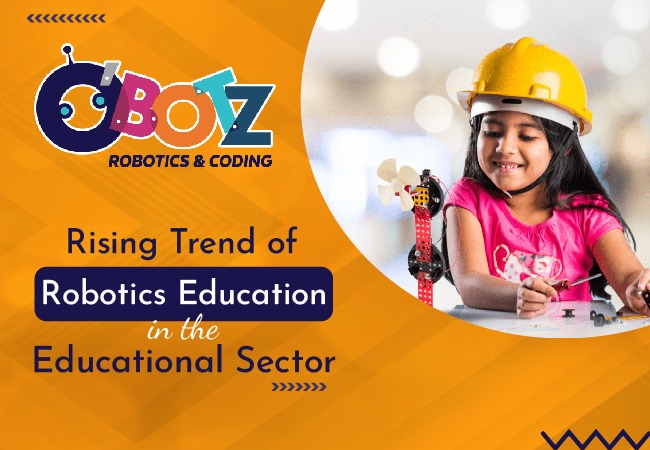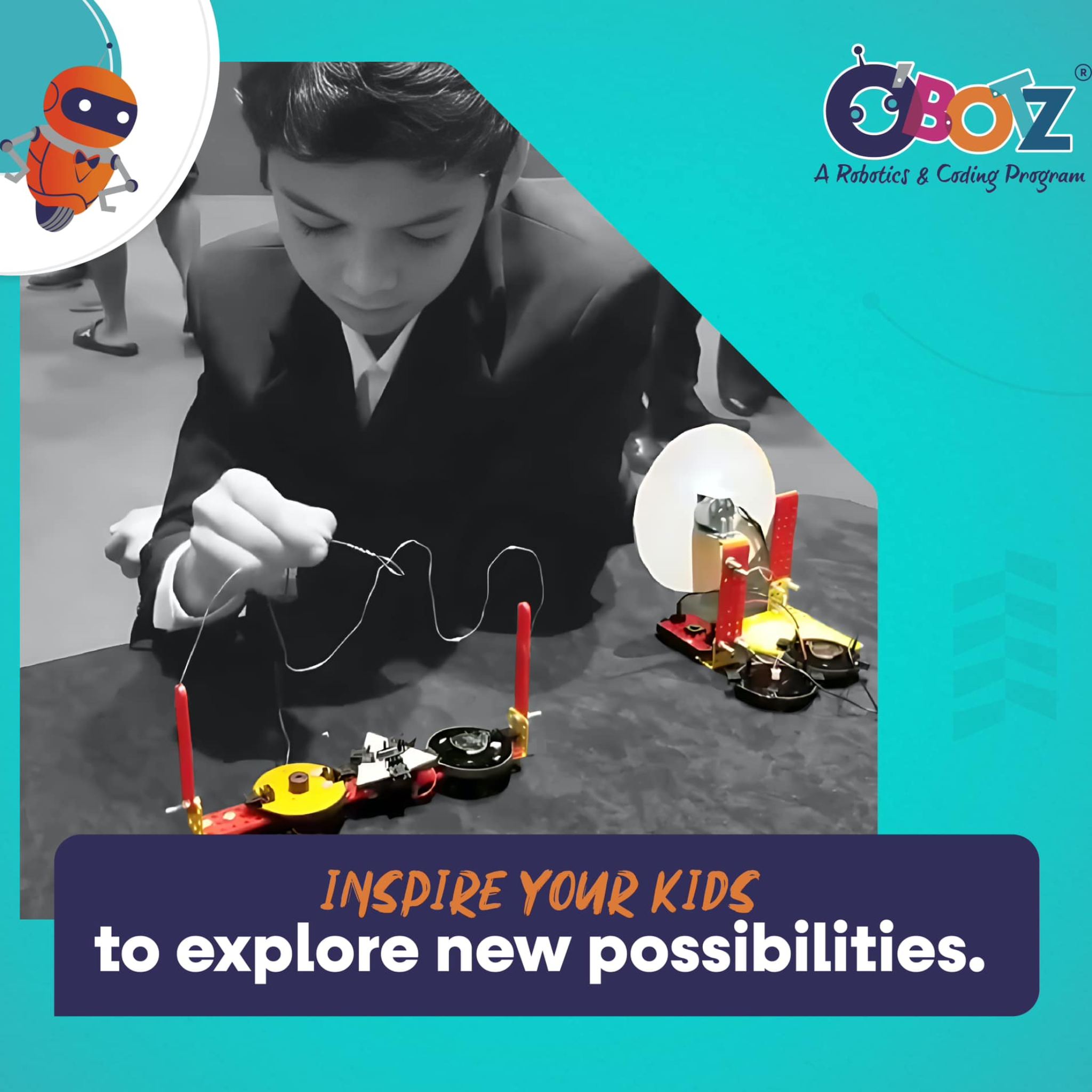Rising Trend of Robotics Education in the Educational Sector
Imagine a classroom where students don’t just learn from textbooks but also from robots. Sounds futuristic, doesn’t it?
Well, at Obotz, we’re turning this futuristic dream into reality! Robotics education is swiftly gaining traction in schools worldwide, transforming the learning experience for students.
In this blog, let’s delve into the wonders of robotics education, its hurdles and why it’s becoming a sensation in schools.
But before we dive deep, let’s begin with the basics: What exactly is Robotics Education ?
Well, at Obotz, we’re turning this futuristic dream into reality! Robotics education is swiftly gaining traction in schools worldwide, transforming the learning experience for students.
In this blog, let’s delve into the wonders of robotics education, its hurdles and why it’s becoming a sensation in schools.
But before we dive deep, let’s begin with the basics: What exactly is Robotics Education ?
At Obotz, we believe it’s more than just building robots, it’s about igniting young minds and shaping a brighter tomorrow.

What is Robotics Education?
At its core, robotics education is the integration of robotics technology into educational programs to enhance learning experiences.
It goes beyond textbooks and lectures, offering students hands-on opportunities to design, build and program robots.
This interdisciplinary approach combines elements of science, technology, engineering and mathematics (STEM), fostering critical thinking, problem-solving skills and creativity among students.
It goes beyond textbooks and lectures, offering students hands-on opportunities to design, build and program robots.
This interdisciplinary approach combines elements of science, technology, engineering and mathematics (STEM), fostering critical thinking, problem-solving skills and creativity among students.


Why is Robotics Education on the Rise?
Several factors contribute to the growing popularity of robotics education in the educational sector:
Robotics education equips students with the knowledge and skills needed to thrive in a technology-driven world, making them future-ready.
Robotics education offers a hands-on and interactive learning experience that appeals to students’ natural curiosity and creativity.
The opportunity to build and program robots makes learning exciting and relevant, motivating students to explore complex concepts in STEM Education.
Students learn by doing, applying scientific principles and mathematical concepts to solve practical problems.
This approach not only enhances understanding but also instills confidence in students as they see the tangible results of their efforts.
It provides opportunities for collaboration, teamwork and peer learning, fostering a supportive and inclusive learning environment where every student can thrive.
By nurturing students’ interest and proficiency in robotics, educational institutions prepare them for lucrative and fulfilling careers in high-demand industries.
Future Readiness
As automation and artificial intelligence redefine industries, there is a growing demand for individuals skilled in robotics and technology.Robotics education equips students with the knowledge and skills needed to thrive in a technology-driven world, making them future-ready.
Engagement and Motivation
Traditional teaching methods often struggle to captivate students’ interest and keep them engaged.Robotics education offers a hands-on and interactive learning experience that appeals to students’ natural curiosity and creativity.
The opportunity to build and program robots makes learning exciting and relevant, motivating students to explore complex concepts in STEM Education.
Real World Application
Robotics education bridges the gap between theoretical knowledge and real-world application.Students learn by doing, applying scientific principles and mathematical concepts to solve practical problems.
This approach not only enhances understanding but also instills confidence in students as they see the tangible results of their efforts.
Inclusivity
Robotics education promotes inclusivity by offering a diverse range of learning experiences that cater to different learning styles and abilities.It provides opportunities for collaboration, teamwork and peer learning, fostering a supportive and inclusive learning environment where every student can thrive.
Career Opportunities
Exposure to robotics education opens doors to a wide range of career opportunities in fields such as robotics engineering, software development, artificial intelligence and automation.By nurturing students’ interest and proficiency in robotics, educational institutions prepare them for lucrative and fulfilling careers in high-demand industries.
Challenges and Solutions
While robotics education offers numerous benefits, it’s not without its challenges.
Limited resources, lack of training for educators and gender differences in STEM fields are just a few obstacles that schools may face.
However, these challenges can be overcome with proper support and investment.
To address resource constraints, schools can explore partnerships with local businesses, organizations and universities.
These collaborations can provide access to funding, equipment and expertise, enriching the robotics education experience for students.
Furthermore, professional development programs for educators are essential for ensuring effective implementation of robotics curriculum.
By equipping teachers with the necessary skills and knowledge, schools can enhance the quality of robotics education and empower educators to inspire the next generation of innovators.
Additionally, efforts to promote diversity and inclusion in STEM must be prioritized.
By actively encouraging participation from underrepresented groups, such as women and minorities, schools can create a more inclusive learning environment and tap into a wider talent pool.
Limited resources, lack of training for educators and gender differences in STEM fields are just a few obstacles that schools may face.
However, these challenges can be overcome with proper support and investment.
To address resource constraints, schools can explore partnerships with local businesses, organizations and universities.
These collaborations can provide access to funding, equipment and expertise, enriching the robotics education experience for students.
Furthermore, professional development programs for educators are essential for ensuring effective implementation of robotics curriculum.
By equipping teachers with the necessary skills and knowledge, schools can enhance the quality of robotics education and empower educators to inspire the next generation of innovators.
Additionally, efforts to promote diversity and inclusion in STEM must be prioritized.
By actively encouraging participation from underrepresented groups, such as women and minorities, schools can create a more inclusive learning environment and tap into a wider talent pool.
The Future of Robotics Education
As technology continues to advance, the possibilities for robotics education are endless.
From coding and artificial intelligence to robotics competitions and industry partnerships, the future of robotics education for Childrens is bright and full of opportunities.
By implementing robotics education, schools can prepare students for the challenges and opportunities of the 21st century.
Whether they pursue careers in robotics, engineering, computer science or other fields, the skills and experiences gained through robotics education will serve them well throughout their lives.
From coding and artificial intelligence to robotics competitions and industry partnerships, the future of robotics education for Childrens is bright and full of opportunities.
By implementing robotics education, schools can prepare students for the challenges and opportunities of the 21st century.
Whether they pursue careers in robotics, engineering, computer science or other fields, the skills and experiences gained through robotics education will serve them well throughout their lives.
Conclusion
In conclusion, robotics education is transforming the educational landscape, ooffering a dynamic and engaging way to learn robotics for kids.
With its focus on hands-on experimentation, STEM skill development and future readiness, robotics education equips students with the tools they need to succeed in an increasingly tech-driven world.
While there are challenges to overcome, the benefits of robotics education far outweigh the obstacles.
By investing in resources, providing training for educators and promoting diversity and inclusion, schools can ensure that all students have access to high-quality robotics education.
So, whether you’re a student, parent or educator, it’s time to embrace the growing trend of robotics education and unlock the full potential of our future innovators and leaders.
Let’s build a world where robots are not just tools, but partners in learning and discovery.
While there are challenges to overcome, the benefits of robotics education far outweigh the obstacles.
By investing in resources, providing training for educators and promoting diversity and inclusion, schools can ensure that all students have access to high-quality robotics education.
So, whether you’re a student, parent or educator, it’s time to embrace the growing trend of robotics education and unlock the full potential of our future innovators and leaders.
Let’s build a world where robots are not just tools, but partners in learning and discovery.



